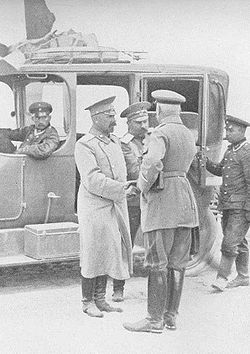Battle of Stalluponen - Picture
More about World War 1

|
|
Battle of Stalluponen
Date
August 17, 1914
Location
Stalluponen, East Prussia (now Nesterov, Russia)
Result
German victory
Date: August 17, 1914
Location: Stalluponen, East Prussia (now Nesterov, Russia)
Result: German victory
Belligerents:
: Russia
Commanders and leaders:
: Paul von Rennenkampf
Strength:
: I Army (200,000)
Casualties and losses:
: 5,000 killed or wounded
3,000 captured
Vistula River - Åx³dź - Limanowa - Bolimx³w - 2nd Masurian Lakes - Gorlice-Tarnx³w - Great Retreat - Sventiany Offensive - Lake Naroch - Brusilov Offensive - Kowel - Kerensky Offensive - Operation Albion
The Battle of Stalluponen, fought between Russian and German armies on August 17, 1914, was the opening battle of World War I on the Eastern Front. It was a minor German success, but did little to upset the Russian timetable.
Prelude
The German Schlieffen Plan was based on defeating France (and the United Kingdom, should it be involved) as quickly as possible in the west, which would then permit the Germans to transport their forces eastward to meet the massive Russian Army. The Russians were able to field up to ten complete armies compared to Germany's eight, but they were scattered across the country and would take some time to organize and move up. This meant that the Germans had a short window of time where they could fight a defensive battle, holding off what forces the Russians could move forward, while they waited for the battles in the west to be decided.
Immediately prior to the opening of hostilities, the Eastern Front developed largely according to pre-war planning. Two Russian armies were in the immediate area, Pavel Rennenkampf's First Army east of the city of Konigsberg, and Alexander Samsonov's Second Army to the south. Rennenkampf planned on marching on Konigsberg, tying down any German forces in the area, while Samsonov would move northwest to cut off any escape.
The Germans were also deployed largely according to everyone's expectations. The German Eighth Army was strung out in pockets in front of Rennenkampf, but did not have the manpower to completely cover the front of either of the Russian armies. On paper, the situation looked almost hopeless, and the standing orders were to fight a delaying retreat. However, Hermann von Franx§ois, the commander of the First Corps of the German Eighth Army, was convinced his better-trained and equipped forces could halt, and perhaps defeat, Rennenkampf's Russian forces.
Most of the Eighth Army was organized into a defensive line running south of Gumbinnen, about 20 miles (32 km) west of the Russian border. However, small units were sent forward to garrison towns, railway lines and strongpoints. They were ordered to retreat on contact with the enemy, joining the main forces at Gumbinnen. For the first five days of the war, the only combat was minor skirmishes with Rennenkampf's cavalry who were conducting reconnaissance along the border area.
The battle

Picture - Hermann von Francois, (with his back to the camera) is greeting the Russian General Klujew, who has been taken prisoner by Francois' troops
On August 17 Rennenkampf started the invasion of East Prussia, marching the First Army directly westward towards the German lines. Although he faced no resistance, Rennenkampf stopped his advance in a neat line about five miles (8 km) from the border. Acting without orders, Francois decided to take his forces to Stalluponen where one of the Russian divisions was resting. A furious frontal attack broke the Russian division, which fled eastward, losing 5,000 casualties and 3,000 prisoners, almost the entirety of the Russian 105th Regiment.
When Prittwitz learned that Franx§ois had engaged the Russians, he sent an adjutant to order Franx§ois to break off the attack and retreat. Franx§ois by this time was too committed to safely disengage, and had no intention of doing so anyway. He contemptuously, and famously, told the adjutant, "Report to General Prittwitz that General von Franx§ois will withdraw when he has defeated the Russians."
Aftermath
While the Russians retreated, Franx§ois pursued them into the evening, but ended his advance when he came under Russian artillery fire. He then reluctantly obeyed Prittwitz's order and withdrew 15 miles (24 km) to the west, taking up new positions around Gumbinnen. His success was infectious, and convinced Prittwitz to be more aggressive in dealing with the Russian forces. This proved to be unwise at the following Battle of Gumbinnen two days later.
More aircraft.
Source: WikiPedia